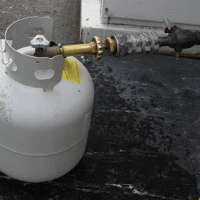Pressurized cylinders filled with various gases are very common, from the propane fuel tank under your barbeque grill to acetylene for welding to fluorine for production of many common products. A leak from almost any of these can cause damage or significant losses, from a fire to physical injury, or asphyxiation.
Owner protection against losses and injury can range from nothing to significant, such as storage in ventilated closets or gas detection alarms. In one case the regulator valve on a small CO2 cylinder used in a bar to pressurize beer kegs broke off. The cylinder rocketed around the bar room, causing at least one serious injury.
Propane or acetylene leakage would typically cause losses from fire, and possibly explosion if it escaped into a closed room and ignited. Carbon dioxide is not flammable or explosive, but in a closed area could displace air sufficiently to suffocate occupants. Hydrogen obviously can burn or explode. But it is odorless, and burns with an almost invisible flame. Hydrogen is the basic fuel for alternative electric automobiles where power comes from H2 – O2 fuel cell generation. H2 – O2 fueled vehicles avoid the hour-long battery charging experienced in battery electric vehicles. We may be seeing hydrogen fill-up pumps at service stations soon!
Warren has investigated many cases of this type. A common thread was whether the leak rate was very slow and there was time for detection and mitigation. Or it was very fast and there was no time for occupants to escape. An investigator may want to know if alarms or other protection provided were adequate to warn of leakage. In such cases, an estimate of the leak rate under given circumstances may be required.
Clearly there are a wide variety of variables in determining leak rate, cylinder size, orifice size, properties of the contents, pressure, whether vented or not, etc. Storage of a gas under pressure also introduces variables not present with liquid filled tanks (Liquid filled tanks were covered in a previous blog – Storage Tank Leaks: Yikes! Where are my boots?). More often than not the conditions are such that the contents are partly liquid and partly vapor, or two-phase. Both normal use or leakage causes boiling to occur. If the vapor pressure exceeds approximately twice atmospheric pressure (the exact value depends on the specific type of gas), the leakage rate is controlled by the sonic velocity in the exit. This is sometimes called “choked” flow.

Gas cylinders come in many shapes and sizes and contain all types of gases. A very familiar one containing propane for a barbeque grille is shown here. The propane is under pressure and if the valve is leaking or opened without being attached to the grill, it could cause a fire or an explosion.
There are actually three separate calculation steps to determine leak rate, (1) discharge of vapor while there is still liquid inside boiling off; (2) liquid is depleted, leaving only vapor, so that tank pressure decreases rapidly; and (3) a final decrease of pressure to atmospheric. Steps (1) and (2) are controlled by compressible flow effects, primarily “choking” in the orifice. Step (3) is essentially a non-compressible flow of fluid through an orifice. Compressible flow equations, using thermodynamic properties for the type of gas and cylinder dimensions, are used to make the specific calculations.
Have you checked your exchanged propane tank’s condition lately?
Founded in 1997, The Warren Group, forensic engineers and consultants provides technical investigations and analysis of personal injury and property claims as well as expert testimony for insurance adjusters and attorneys. Extremely well versed in the disciplines of mechanical, electrical, chemical, structural, accident reconstruction and fire and explosion investigation, our engineers and consultants are known for delivering the truth — origin, cause, responsibility and cost of an event or claim — with unmistakable clarity.



